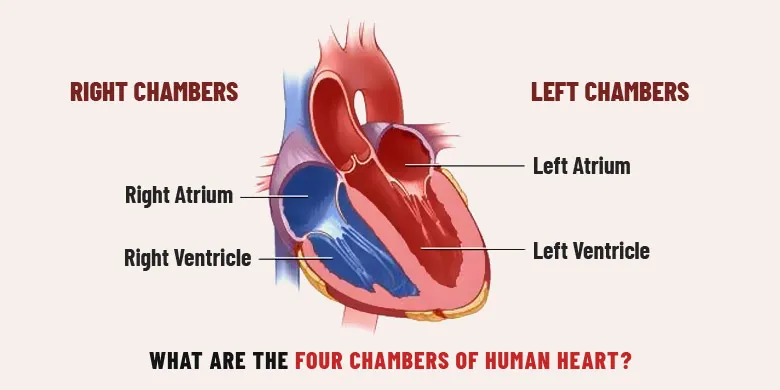What Are the Four Chambers of Human Heart?
A powerful natural pump in your body, the heart uses its chambers to manage the flow of blood in two distinct circuits, i.e. the systemic and pulmonary bloodstreams. Like the brain, the heart continues working tirelessly without stopping for a second and it makes the blood flow through all the blood vessels in your body in one minute! So, what are the four chambers of human heart? Read on to find useful information on the topic.
Here’s you’ll get answers to the questions, like:
- How does the heart manage the flow of blood in two distinct circuits?
- What are the four chambers of the heart?
- What controls the unidirectional flow of the blood from one chamber to another?
Richard Klabunde, the author of Cardiovascular Physiology Concepts, contradicts the idea that the heart is solely responsible for pumping the blood through the organs of your body. According to the researcher, the heart as a pump only receives the blood from the venous blood vessels at low pressure, raises it to a higher pressure by contracting around it within the heart chambers, and then pushes it into the arterial blood vessels.
So, the flow of the blood is not driven by the output of the pumping organ by itself, but rather by the pressure that is generated within the arterial system as the heart pumps the blood into the vast network of vessels.
How does the heart manage the flow of blood in two distinct circuits?
As the major organ of the cardiovascular system, the heart manages the flow of the circulatory fluid, i.e. the blood, in both the systemic and the pulmonary circulations. For this purpose, it has four chambers.
Systemic circulation is that component of the cardiovascular system which is responsible for circulating the oxygenated blood to the head, arms, liver, gastrointestinal tract, kidneys, legs and other organs of the body. It also collects the deoxygenated blood and brings it back to the heart. Systemic circulation begins from the left ventricle and aorta and extends to the junction of the superior vena cava (SVC) and inferior vena cava (IVC) at the level of the right atrium.
The second component of the cardiovascular system, i.e. the pulmonary circulation, is responsible for providing the heart with well-oxygenated blood. It circulates the blood between the heart and the lungs. This circuit begins at the level of the pulmonary artery which receives the blood from the right ventricle and ends at the level of left atrium which receives the oxygenated blood from the lungs through the pulmonary vein.
The pulmonary circulation makes a low pressure and high flow circuit, which not only helps the right ventricle operate at a low energy cost but also promotes the exchange of gases in the lungs by preventing the fluid moving out of the pulmonary vessels into the interstitial spaces.
What are the four chambers of the heart?
The four chambers of the heart are the right atrium (RA), right ventricle (RV), left atrium (LA) and left ventricle (LV).
Here’s how the four chambers of the heart manage the flow of blood in two circuits.

The right atrium receives deoxygenated blood from different parts of the body through two large veins, i.e. the super vena cava and inferior vena cava. The inferior vena cava is also the largest vein in your body. The blood from the right atrium enters the right ventricle (RV). From RV, it enters the pulmonary artery which takes it to the lungs for oxygenation through the pulmonary circulation. From the lungs, the oxygenated blood flows into the left atrium (LA). The LA delivers the fluid to the left ventricle (LV). Now it is from LV that the blood flows into the aorta – the largest artery in your body – for distribution to the different organs of the body.
What controls the unidirectional flow of the blood from one chamber to another?
After you have got an answer to the main question, “What are the four chambers of the human heart?” it is pertinent to discuss how different chambers of the heart ensure the unidirectional flow of the blood. It is due to the presence of the heart valves that the pumping organ prevents the backflow of the blood.
There are four heart valves in total, namely, the bicuspid valve, the tricuspid valve, the aortic valve, and the pulmonary valve. The bicuspid (or the mitral) and the tricuspid valves lie between the atria and the ventricles. The aortic valve lies between the left ventricle and the aorta, and the pulmonary valve is present between the pulmonary artery and the right ventricle.


